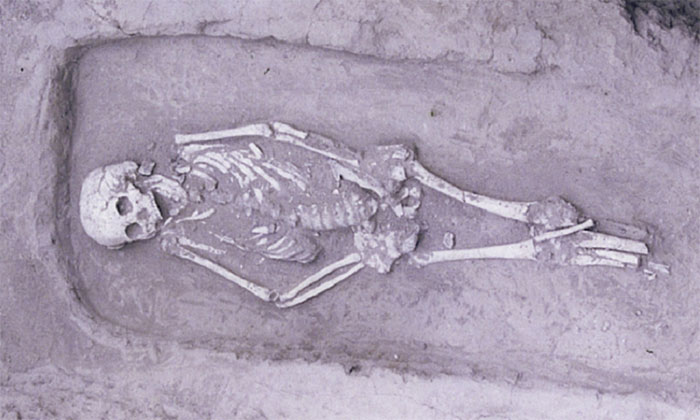5,000-year-old remains of rare dwarf syndrome
Archaeologists discovered the tiny remains of a young man suffering from "dwarf" syndrome in the Neolithic tomb.
The team found the skeleton at a cemetery near the Yellow River in central eastern China along with many other remains of residents living between 3300 and 2900 BC. All remains were in the position of hands on the abdomen, except for a dead person who had his hands behind his back. This person's bone appears to be shorter and weaker than the rest of the skeleton. Upon closer inspection, archaeologists speculated that young people in the tomb had dwarf syndrome.

The remains of young people suffering from "balanced dwarf syndrome".(Photo: Live Science).
Dwarf syndrome often disrupts bone growth, making the person shorter than average, according to a report published on December 13 in the International Journal of Paleopathology. Dwarf syndrome is quite rare in modern humans, occurring only in the incidence of about 3.22 per 10,000 births, but even rarer in archaeological records. So far, researchers have discovered less than 40 cases. Among them, most have a relatively common form called cartilage dysplasia, causing the limbs to grow shorter in proportion to the head and body disproportionately.
However, the team at the ancient cemetery quickly realized their findings were even more rare. While the limbs of the skeleton seem short, the head and torso bones are also quite small. Based on the teeth, the researchers said the remains belonged to a young man, who concluded that the " dwarf syndrome " in the Neolithic skeleton was not only rare in archeology but also in today's population. .
The team hypothesized that dwarfism in the dead results from hypopituitarism or hypothyroidism in children. Most likely the patient has pituitary gland or underactive thyroid from an early age. Both glands govern hormone activity throughout the body. Without signals from them, the tissues and organs may not grow fully. The syndrome also disrupts bone growth, cognitive ability and cardiopulmonary function. The team thinks the dead may be helped by community members to survive.
Unlike cartilage dysplasia, which is often caused by a genetic mutation, pituitary and thyroid dysfunction is thought to be related to a lack of essential nutrients like iodine. Although the buried skeleton was different from nearby corpses, the team was unsure how the dead were treated in life.
- Found a way to reverse dwarf syndrome
- Found a way to reverse dwarf syndrome
- Strange disease: The boy has a face
- Rare dwarf elephants die in mass
- The 5-year-old girl has half her body growing faster than the other half
- 'Hunting' is a photo of dwarf hippo that is about to become extinct
- Found the thousand-year-old 'golden warrior' in Kazakhstan
- Beautiful photos of rare dwarf planet Ceres
- 97 5,000-year-old remains were deformed in a house of 20 square meters
- Learn about the rare disease called: Apert Syndrome
- She has a face deformed by rare syndrome
- Dance of the dead planet signals life
- Mysterious remains of women belong to another human species
 'Fine laughs' - Scary and painful torture in ancient times
'Fine laughs' - Scary and painful torture in ancient times The sequence of numbers 142857 of the Egyptian pyramids is known as the strangest number in the world - Why?
The sequence of numbers 142857 of the Egyptian pyramids is known as the strangest number in the world - Why? History of the iron
History of the iron What is alum?
What is alum?